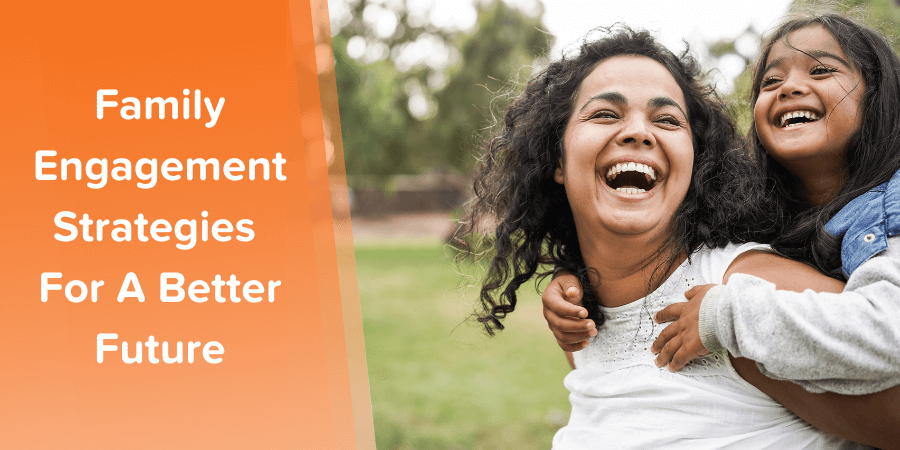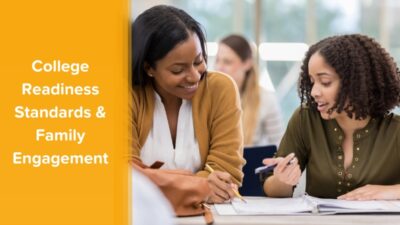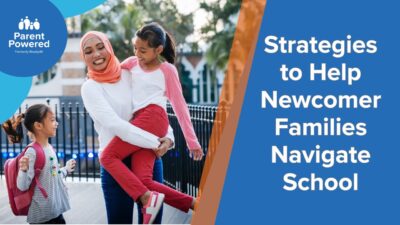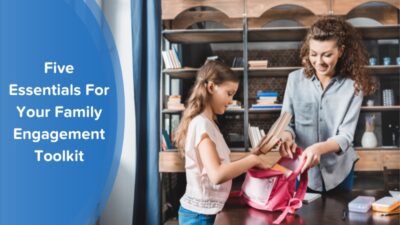By Maren Madalyn, contributing writer
“Are family and community engagement essential for student success?”
If I were to pick up the phone today and contact any number of educators across the United States, I would bet that most educators would answer “Yes” (if not “Heck yes!”) to this question.
Admittedly, I recently did just that, hoping to discover schools’ top priorities as we all navigate the ripple effects of the pandemic in education. Over the course of several interviews with school and district leaders from our partner network, I kept hearing the same sentiment reiterated in each conversation: that positive family engagement, and building trusting relationships with families, was a huge goal for their teams.

Their feedback underscored for me the remarkable changes we’ve seen in family-school partnerships over the past few years. Most educators recognize that families play a critical role – an essential one – in student learning. But this hasn’t always been the case in the history of education. In fact, family engagement strategies and expectations around family support for learning have evolved significantly since schools were first founded here in the United States.
As educators look for ways to create more equitable learning opportunities for students, we first need to understand where we’ve come from. By examining the origins of today’s family engagement initiatives – and how the vital role of families in a child’s educational experience has shifted – we can discover how systemic family engagement needs to evolve going forward to benefit all students.
Looking back: a brief history of family engagement
The creation of public education in the US marked a pivotal shift in how states funded widespread learning experiences for children. Although the first tuition-free schools were founded in the early 19th century, it would take multiple decades before universal public education was embraced across all US states. And even then, many students and families were excluded from public schools based on race, gender, physical ability, and citizenship status. Access to education was severely limited for many families.
For other families whose students could attend public school, parents were not expected to support learning directly. School program staff did not encourage active participation in school activities or otherwise invite families to get involved. Families rarely entered the building, and schools did not invest much energy or professional development into family relationships. Why?
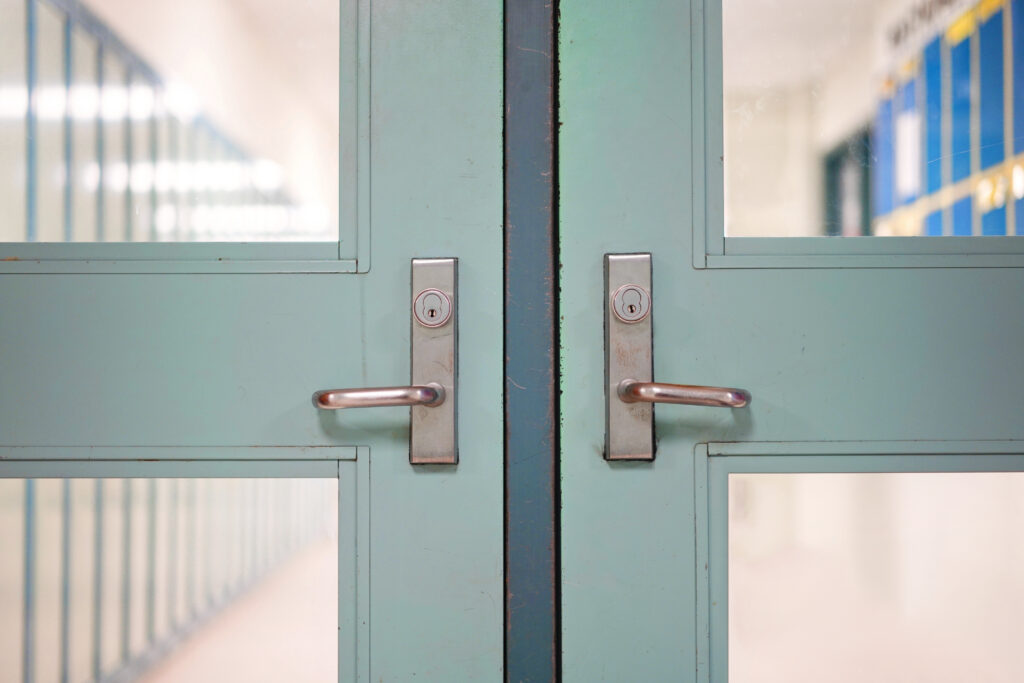
Though incredibly different from today’s climate of engaging families, this context makes sense if we understand how and why public schools were developed in the first place. To put it simply, the earliest schools were designed to provide all the teaching and learning that a student needs, without bringing families directly into the loop. As the Brookings Institute explains, “the implicit understanding between schools and families was that communities would support school infrastructure, families would bring their children to schools, and schools would simply take care of the rest.”
In this system, many parents had little knowledge or influence in their school community or on student development, save for very few already-enfranchised individuals. Schools made nearly all decisions about education, as teachers and school leaders were considered the experts on learning. Families were encouraged to instead focus on a child’s life outside of the classroom.
Why does this history matter for understanding family and parental involvement in schools today?
For starters, schools did not have a framework or any guidelines for inviting families into collaboration – it simply was not part of the teaching culture. Over time, as schools shifted away from this mindset of holding sole responsibility for a child’s educational experience, educators needed to figure out how to embrace and create authentic and equitable partnerships between school and home
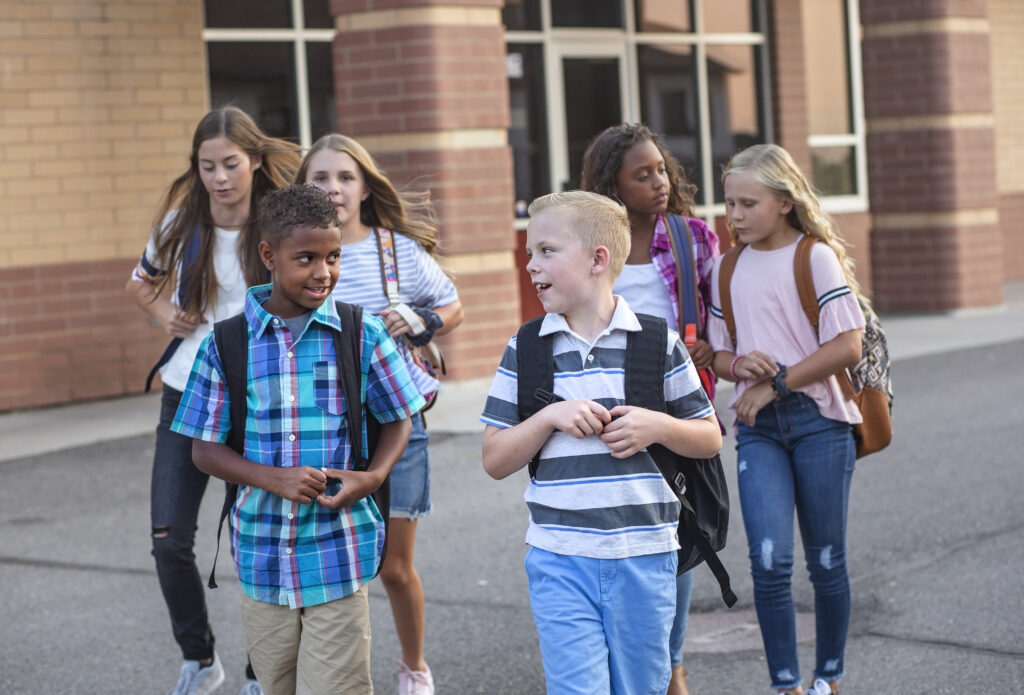
Second, the earliest tuition-free schools were only accessible to a limited number of children from specific cultural backgrounds. As public education slowly became more accessible to more families, teachers and administrators also needed to learn how to support increasingly diverse and unique community members.
So, bearing this context in mind, how does this history compare with the family engagement strategies used today?

Family engagement strategies today
Nowadays, it’s hard to find a school that doesn’t offer at least some opportunity for parents, caregivers, and guardians to participate in school affairs. Open House, Back-to-School Night, parent volunteering days, parent leadership councils – do any of these examples sound familiar? By and large, multiple forms of family involvement have become regular practice for many school and community organizations.
This more recent expansion of family and parent involvement in schools makes sense, too. Numerous research studies have helped the education community understand that family engagement strategies can directly support academic achievement, graduation rates, and even teacher satisfaction.
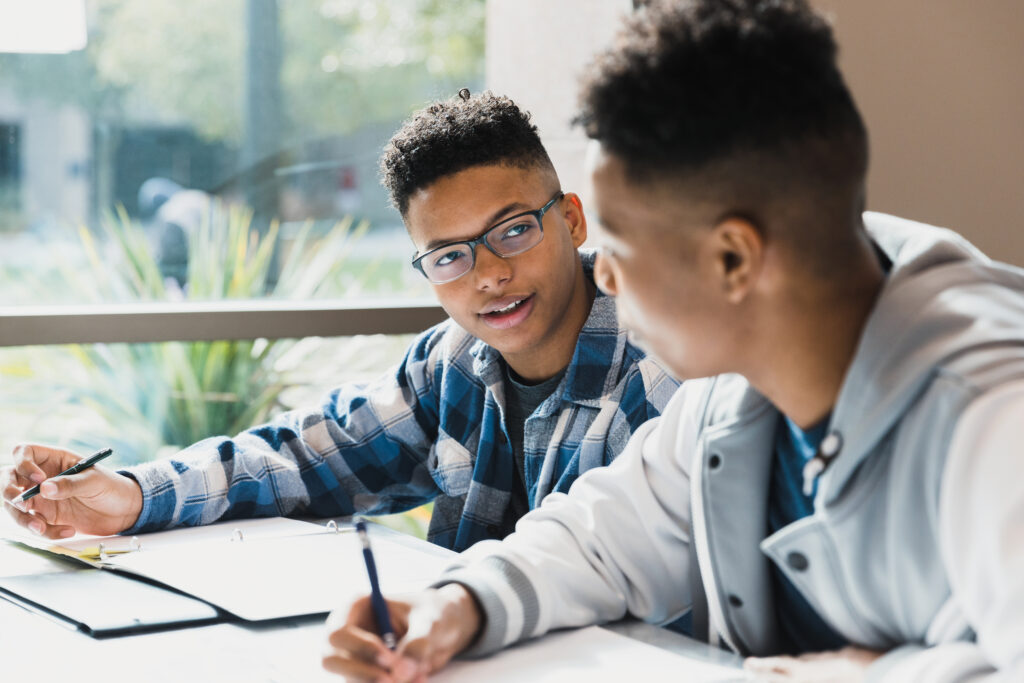
Even in the last two years, studies on the impact of the COVID-19 pandemic have revealed just how crucial families are and will continue to be to recover from the fallout reported in student math and reading scores. It’s no wonder why school teams want to leverage the many benefits unlocked when they engage families.
Despite these recent advances, educators still face challenges with building family-school partnerships, which we’ve learned stem from public schools’ history. Family engagement strategies can be especially challenging for school communities that serve families with diverse cultural backgrounds and experiences – many of whom could not access public schooling in the earliest days. Barriers to engagement limit parent capacity to get involved and can include transportation costs, different language proficiencies, or sufficient time available for participation.
The COVID-19 pandemic revealed further gaps in current approaches to engaging families, too, as previously implemented methods were suddenly flipped on their heads as schools closed their doors. On one hand, parents, caregivers, and guardians needed to facilitate student learning at home, relying on communications and additional resources provided by their schools. On the other hand, teachers needed to constantly curate tools and educational activities to provide families guidance to drive that learning. On top of this role-reversal, both parties also navigated major challenges with equity, mental wellbeing, and constantly changing circumstances – many of which continue to impact families and schools today.
As ParentPowered repeatedly heard from our partners at the height of school shutdowns– school administrators and teachers had to radically shift family engagement strategies, as well as communication between school and home, to respond to these emergent challenges and unique needs of their community.
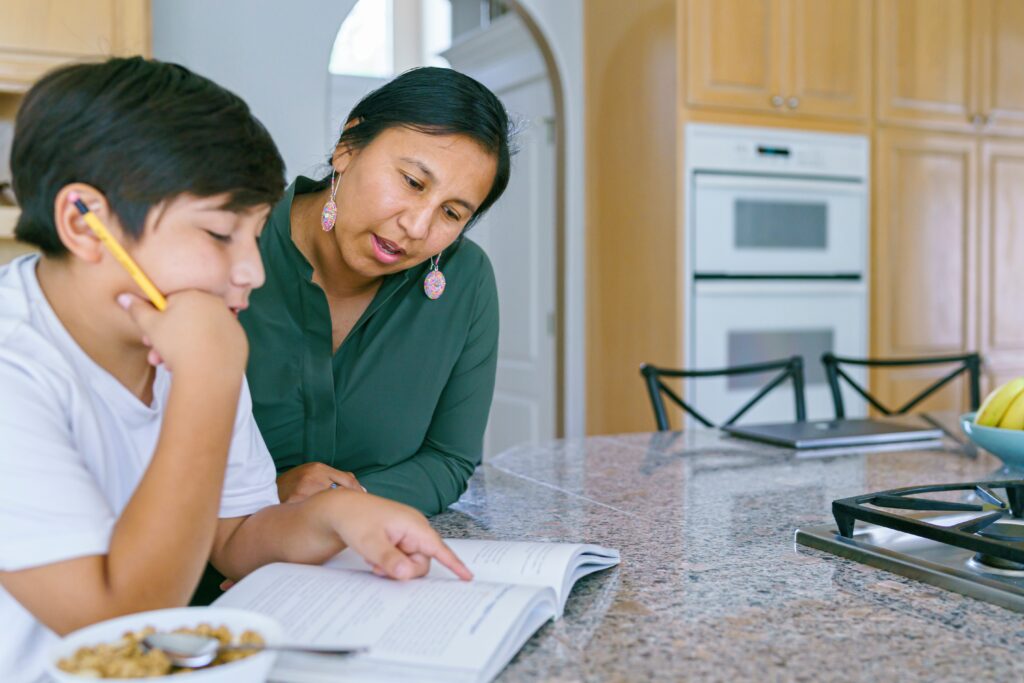
Today, we are all still wading amidst the ripple effects of the pandemic. Authentically engaged family-school partnerships are perhaps more crucial now than ever before.
Here’s the good news: educators have an amazing opportunity to redesign and strengthen family engagement strategies today for a more equitable tomorrow. We have a chance to rethink our current approaches, challenge previously held mindsets, and develop methods for building relationships with families – all families – that make a lasting impact on students and school improvement for the better.

Looking ahead: family engagement for the future
What could evolved family engagement practices look like for students, schools, educators, and families?
A year before US schools shut their doors in 2020, Dr. Karen Mapp of Harvard’s Graduate School of Education republished her framework guiding organizational approaches to engage families in partnership. Called the Dual Capacity-Building Framework, the model emphasizes that the most effective family engagement strategies are:
- Relational (build on mutual trust)
- Asset or strengths-based
- Culturally responsive and respectively
- Collaborative and interactive
- Connected to learning and development
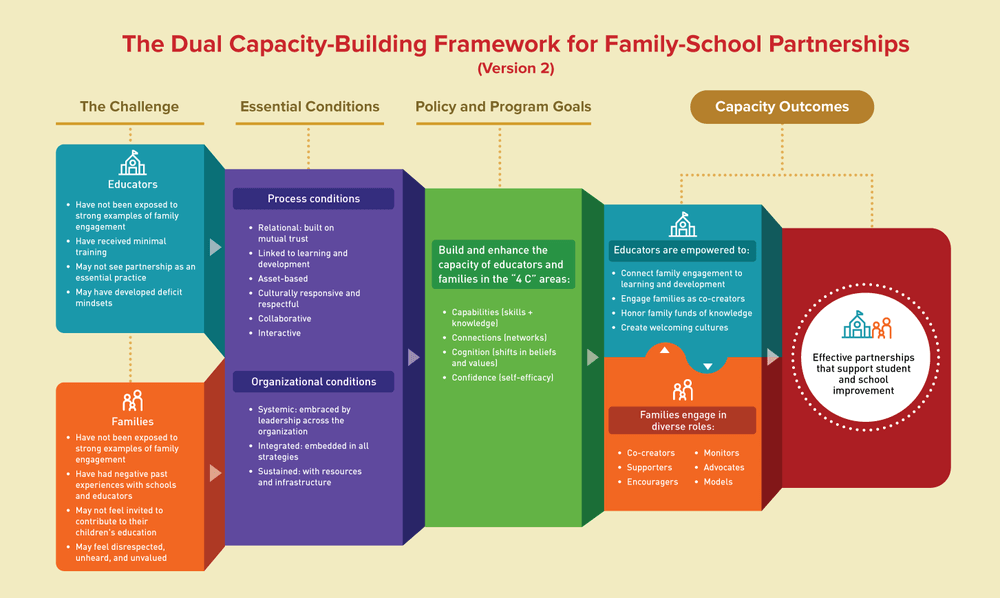
These five guidelines are deeply interconnected and reinforce one another. For example, when a teacher uses culturally responsive communication with family members in their community, that family’s trust in the school team deepens. This in turn encourages the engaged family to share more openly with schools – creating more collaboration opportunities that benefit students’ school life.
Whether you are sharing a simple at-home learning activity or building an entire family engagement program, these guiding principles offer a pathway toward meaningful communication and collaboration with families. Administrators and teachers who incorporate these themes into family engagement strategies for schools open the doors for every family to serve their children’s education.
Let’s examine these essential conditions and how we might evolve our programs to cultivate them.
Building relational trust
Trust is essential for any healthy relationship, including family-school partnerships. It comes down to establishing mutual respect among essential adults surrounding a child – all centered on a student’s success at home and in the classroom. Building trust will be a critical theme in family engagement strategies going forward.
Trust takes time and effort invested to grow, but a great place to begin is by using reciprocal communication to engage families. Even the smallest moments, like teachers conversing with parents at the school drop-off, are opportunities for educators to cultivate connections. Consider the following communication tools as you strategize trust-building in your family relationships:
- Active listening – This invaluable communication skill is essential for building trust in a relationship. In fact, you can nurture an active listening culture among your entire community. When used well, active listening can greatly improve communication between educators and families, as well as among school staff. Read our recent post to discover the power of active listening for student learning, family engagement, and even school climate.
- Two-way communication routines – When two parties collaborate together, information must flow in both directions between them for their partnership to work. Support low-effort, consistent routines that encourage bidirectional communication between school and home, where parents share input about their child to their teacher as often as your staff share information from school. Take a look at our guide to crafting communications with families for more information.
By creating an environment where families feel valued and respected, educators ensure trust has room to grow. A strong relationship between school and home allows the full learning team to collectively advocate for their children’s education and wellbeing.

Focusing on strengths and assets
Strengths-based family engagement is another key approach for educators going forward. Originating in social work family practices, strengths-based methods emphasize a family’s strengths and assets, such as knowledge or local resources, rather than pointing to deficits. They uplift the role of families by encouraging family members to use valuable resources they already have in service of learning.
A strengths-based approach to engaging families is powerful in two ways. First, by concentrating on existing potential and opportunity, educators remind parents, caregivers, and guardians that they can – and often already are – directly supporting their children’s development. Second, these strategies encourage families to get involved in accessible ways already available to them, without adding extra costs, resources, or time to their plates. Both of these aspects invite families into student education using their assets.
Ultimately, a strengths-based approach to family engagement works to foster positive, joyful relationships among educators, students, and their families – helping all children reach their full potential. Here are a few ways schools can develop assets-focused family engagement strategies in their own communities:

- Understand your families’ most critical needs – Family lives outside of the classroom directly impact a student’s experiences at school. Explore ways you can help families gain access to community programs and resources that meet their essential needs. This support boosts a family’s capacity to participate in their child’s learning. Read on to learn how connecting families with community resources improves family-school partnerships.
- Celebrate parent expertise – As the first teachers in a child’s life, parents and other family members raising children have a wealth of knowledge to offer educators. Find ways to honor this expertise. For example, invite parents to actively contribute to solutions and decision-making about student learning. Families are advocates for children’s learning, just like a teacher or an administrator. Not only does this knowledge complement your team’s expertise in learning science, it also encourages family confidence in their own autonomy. In the end, such partnership makes learning possible.
Take a look at our recent blog post highlighting inspiring examples of strengths-based family engagement strategies from fellow educators in the field.

Respecting all cultures and backgrounds
Cultural responsiveness will be another key element for educators to harness as they engage families. Culturally responsive family engagement emphasizes creating an inclusive learning environment in which all types of families and students can thrive. When implemented well, these approaches ensure that all families feel welcomed, respected, and valued in the school community – regardless of their cultural backgrounds.
Cultural responsiveness also helps create equitable pathways to invite families into partnerships, which are critical for supporting historically underserved families. By making family engagement opportunities accessible (say, by translating surveys into Spanish for Spanish-speaking families), school leaders can weave voices from their entire community into decisions and solutions. They ensure everyone has a seat at the table.

Start building culturally responsive partnerships with your families with these foundational steps:
- Audit your existing practices – Examine the impact of your existing family engagement and communication strategies from a variety of perspectives. Your planning team can ask themselves questions such as “Which voices are missing from our family communications?” and “Do we ask for a family’s language preference when planning our outreach?” to explore if your family engagement practices are accessible to everyone, regardless of economic or cultural backgrounds.
- Set the tone from the start – When families first join a school community, it’s a wonderful opportunity to make a great first impression and truly welcome them. Try posting signs in different languages around campus, or show photos (with permission) of families from the community in classrooms. Schools can also go beyond simply translating take-home materials into families’ home languages to make them feel welcome. Consider highlighting books in your curriculum that specifically celebrate unique cultures found in your school community. Be sure any strategy used to build a great first impression applies trauma-informed approaches, too.
- Establish consistent listening opportunities – In addition to practicing active listening themselves, your staff can set up reliable spaces and channels for families to share their input back with their schools. Family surveys are an excellent way to solicit feedback. Just be sure you can translate both the surveys and your family responses! Leveraging community partnerships is another way that schools support families to share their input. Consider hosting a school Q&A session or family workshop at a local youth center, religious organization, or other space where families gather regularly.
Discover the next phase of partnership in our recent blog post or download our tip sheet for more inspiration.

Collaborating for student learning
In a truly reciprocal partnership, both parties work together to cultivate child development and growth. This shared responsibility and investment help students navigate difficult situations and celebrate milestones of success. Going forward, effective family engagement strategies will encourage collaboration and support interactive learning for students, families, and school staff.
In particular, schools can empower families to take the lead in driving learning outside of the classroom community. Families may not realize just how many educational opportunities exist in their daily lives. Interactive family engagement activities at home are an excellent way for families to tap into such moments.
Consider the following ways that your organization can encourage collaborative family engagement beyond the classroom:
- Integrate learning moments into everyday routines – Families often report that lack of time affects their capacity for family involvement in school. Try offering age-appropriate learning activities that fit into existing home routines to help parents navigate time constraints. For example, encourage families to use mealtime preparations as a learning moment by inviting children to read the recipe and ingredients aloud as they cook. These methods are especially helpful for early childhood education, as young kids build many crucial foundational skills before age 5. For more examples of at-home learning that boost reading skills, read our recent post about bringing the science of reading home.
- Share resources via text – Research shows that text messaging is the most effective means of communication between schools and families. Text messages are short, sweet, and don’t require specific resources such as internet access – making them more accessible for many families. Offer ways for families to get involved in student learning via text, such as sending them simple activities that they can do with children during their drive to school. You can also engage in purposeful communication with family members via text. For example, try sending family feedback surveys, connecting families with new resources, or encouraging them to participate in local educational programs through text.
Our ParentPowered suite of family engagement curricula is designed specifically with these collaboration practices in mind. Take a look at our sample messages or contact us to learn how we deliver evidence-based learning moments to families supporting students aged birth through adolescence.

Equitable family engagement strategies for all communities
No one expects families and schools to revert to the early days of family-school relationships, where schools manage how children learn and limit the role of families to spectating. Even many pre-COVID family engagement strategies offer ripe opportunities for change and improvement.
We can certainly find inspiring examples of positive family engagement from the field demonstrating the power of shifting these practices. While you’ll notice that many of these approaches share these essential conditions outlined in Dr. Mapp’s framework, it is most crucial to find the family engagement strategies that work best for your students, leaders, staff, and families.
And, we will continue to learn and grow and evolve our family-school partnerships, just as schools have been ever since the very first classroom doors opened. Though I cannot say what the future holds for us in education – I can say with certainty that our students’ families will be by our side on the journey, moving forward as some of our closest partners and allies.

About the author
Maren Madalyn has worked at the intersection of K12 education and technology for over a decade, serving in roles ranging from counseling to customer success to product management. She blends this expertise with fluid writing and strategic problem-solving to help education organizations create thoughtful long-form content that empowers educators.

